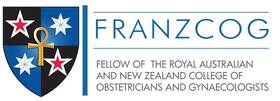|
Dr Sherif Tawfeek, Gynaecologist - SJOG Midland Gynaecology Perth
Factors predisposing women to have Laparoscopy for Chronic pelvic Pain
Chronic pelvic pain (CPP) can be challenging to treat; holistic team approach is often required. Several factors have been identified as predisposing to CPP and knowledge of these is useful when determining an individual threshold for laparoscopy. Teenagers, smoking, low body mass index, sterilisation, sexual abuse and psychological symptoms have been associated with painful periods, whereas exercise and oral contraception have been less associated with pain. Anxiety, depression, miscarriage, caesarean section, drug and alcohol misuse, longer menstrual flow, on going pelvic inflammatory infection and pelvic adhestions are associated with non-cyclical pelvic pain. Progesterone supplements do NOT improve outcomes for women with recurrent miscarriages
Progesterone in recurrent miscarriages (PROMISE) study was undertaken to test whether giving the hormone progesterone to pregnant women with a history of repeated unexplained early pregnancy losses could increase the number of pregnancies leading to live births. The results are bound to be disappointing to many couples affected by miscarriage. However, there are some positives. Is bladder pain syndrome/interstitial cystitis a risk factor for hysterectomy?
Recently, investigators have shown that patients with Bladder pain syndrome/ interstitial cystitis (BPS/IC) more likely than those without to have a history of surgery (read more). An American study showed women with BPS/IC had a statistically higher prevalence of hysterectomies 42% (controls 21%) . Of women with BPS/IC who had hysterectomies, 68% of the hysterectomies were done before their diagnosis of BPS/IC, and only 21% were done after their BPS/IC diagnosis. This proves that the majority of BPS/IC were undiagnosed at the time of hysterectomy. The diagnosis of BPS/IC can take up to 5 years after hysterectomy in most cases. How can I prevent my daughter of developing endometriosis?
You can't prevent endometriosis. But you can reduce your daughter chances of developing endometriosis by controlling some risk factors. Intense researches are underway to confirm the association of these factors and endometriosis. First we need to identify the general risks factors. Risk factors in childhood:
What are the natural ways to control endometriosis? Is there a link between endometriosis and ovarian cancers?
Women with a history of endometriosis are at a significantly increased risk of developing certain types of ovarian cancers, according to a study published in the Lancet Oncology. According to this article study, women with endometriosis have an odds ratio of about 1.5 of developing an invasive ovarian cancer compared to the general female population. Interstitial Cystitis - Endometriosis’ “Evil Twin”
Interstitial Cystitis (IC) is called by gynaecologists “the evil twin of endometriosis”. It is a disease that often goes undiagnosed. IC is a chronic condition also known as painful bladder syndrome. Painful menstrual cycles and painful intercourse may not only be due to endometriosis as the studies have shown that 50-84% of women with endometriosis may also have IC. IC occurs when there is a defect in the lining of the bladder. Eating foods high in acids or those high in potassium (read more here) cause acids and potassium to permeate through the bladder wall and set off chain reactions of inflammation resulting in pain. Symptoms include urinary urgency, frequency and pelvic pain in the absence of urinary tract infection. Although these symptoms represent the classic triad of IC, some patients have no pain and present with symptoms of overactive bladder. In addition, 15% of patients present with chronic pain and no urologic symptoms. Does cesarean section increase the risk of endometriosis?
Compared with vaginal deliveries, cesarean sections may be associated with an increased risk of endometriosis, according to the findings of a large study conducted in Sweden. Women who had a cesarean section were 80% more likely than women who had a vaginal delivery to receive an in-hospital diagnosis of endometriosis after delivery of their first child. 179 million women worldwide suffer from pelvic pain. Is endometriosis behind it all?
The exact cause of endometriosis is unclear. Unfortunately, due to a widespread lack of awareness, women and girls go an average of nearly a decade before their symptoms are accurately diagnosed and appropriately treated. This obviously will have an impact on their social and sexual lives. In addition 25-35% will have their fertility reduced. Therefore an endometriosis specialist referral is recommended.
Letrozole may help women with polycystic ovarian syndrome become pregnant
The drug letrozole is used to induce ovulation. The studies showed using Letrozole results in higher birth rates in women with polycystic ovarian syndrome (PCOs) than the current preferred infertility treatment drug, according to a nationwide American study. PCOS affects 5 to 10 percent of reproductive-age women and is the most common cause of female infertility. Women affected have excessive levels of the hormone androgen, have infrequent periods, develop small cysts on the ovaries and have trouble conceiving. Caesarean babies more likely to become overweight as adults, analysis finds
Babies born by caesarean section are more likely to be overweight or obese as adults, according to a new analysis that is based on over 38,000 individuals. The odds of being overweight or obese are 26% higher for adults born by caesarean section than those born by vaginal delivery, the study found. The three-minute hysterectomy for all
DailyMail-UK: "Thousands of women will be spared the misery of a hysterectomy by an amazing alternative that can be carried out in a lunch break!" This treatment is takes just three minutes and it is called ENDOMETRIAL ABLATION. Gynaecologists use a hand-held 'wand' emitting low-powered energy to remove the lining of the uterus quickly and safely. It was given the backing of Government health advisers. Endometrial Ablation is a simple technique that could save thousands of women the pain and the long recovery period of a hysterectomy. Unfortunately endometrial ablation is not suitable for every woman, therefore each individual needs to be assessed by gynaecologist prior to her surgery. Today, women experience up to 10 times more menstrual cycles than their ancestors did.
The diagnosis of heavy periods is notoriously difficult. It is subjective and dependant on patient history. Only 40% of women with convincing history for menorrhagia will have a loss of >80ml/cycle. This is important as medical treatment for heavy periods is unlikely to be effective in those with normal blood loss. Therefore, it is important to seek medical advise by a gynaecologist making the right diagnosis for the appropriate treatment options.
Miscarriage Can Be Prevented.
Miscarriage occurs in 15–25% of clinical pregnancies and accounts for more than 50,000 inpatient admissions to hospitals in the UK annually. Without medical intervention, the painful pattern of miscarriage can occur again and again.
Vitamin D deficiency may reduce pregnancy rate in women undergoing IVF
Women with a vitamin D deficiency were nearly half as likely to conceive through in vitro fertilization (IVF) as women who had sufficient levels of the vitamin, according to a new study. Long known for its role in bone health, vitamin D is a steroid hormone that is emerging as a factor in fertility. |
This animation shows one of the methods of Endometrial Ablation
Trans-Obturator bladder sling surgery for stress incontinence
Sherif Tawfeek
|

